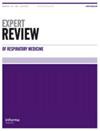Urine biomarkers of pulmonary tuberculosis
IF 2.9
3区 医学
Q2 RESPIRATORY SYSTEM
引用次数: 3
Abstract
ABSTRACT Introduction Sputum-based tuberculosis diagnosis does not address the needs of certain categories of patients. Active development of a noninvasive urine-based diagnosis could provide an alternative approach. We reviewed publications covering more than 30 urine biomarkers proposed as significant for TB diagnosis. Analytical approaches were heterogeneous in design and methods; few studies on diagnostic outcome prediction described a formal specificity and sensitivity analysis. Areas covered This review describes studies of non-sputum diagnostic approaches of pulmonary TB based on urine using specific TB biomarkers. The search was performed until December 2021, using terms [Tuberculosis] + [urine] + [biomarkers] in PubMed and Cochrane databases. Publications concerning LAM urine diagnostics were excluded as they have been described elsewhere. Expert opinion Microbiological culture of sputum is considered to be the ‘gold standard’ diagnostic for pulmonary TB but the methodology is slow due to the slow growth of the TB bacteria. Urine provides a large volume of sample. Investigators have evaluated urine for either TB pathogen biomarkers or host biomarkers with some success as the review demonstrates. Detection sensitivity remains a significant problem. In future, combination of host and pathogen biomarkers could increase the sensitivity and specificity of TB diagnosis.肺结核的尿液生物标志物
基于痰液的结核病诊断不能满足某些类别患者的需求。积极发展无创尿液诊断可以提供另一种方法。我们回顾了30多种被认为对结核病诊断有重要意义的尿液生物标志物。分析方法在设计和方法上各不相同;很少有关于诊断结果预测的研究描述了正式的特异性和敏感性分析。本综述描述了基于尿液使用特异性结核生物标志物的非痰诊断方法的研究。检索持续到2021年12月,检索词为PubMed和Cochrane数据库中的[结核病]+[尿液]+[生物标志物]。关于LAM尿液诊断的出版物被排除在外,因为它们已在其他地方描述。专家意见痰液微生物培养被认为是诊断肺结核的“金标准”,但由于结核细菌生长缓慢,该方法比较缓慢。尿液提供了大量的样本。正如综述所示,研究人员已经评估了尿液中的结核病原体生物标志物或宿主生物标志物,并取得了一些成功。检测灵敏度仍然是一个重大问题。未来,结合宿主和病原体生物标志物可提高结核病诊断的敏感性和特异性。
本文章由计算机程序翻译,如有差异,请以英文原文为准。
求助全文
约1分钟内获得全文
求助全文
来源期刊

Expert Review of Respiratory Medicine
RESPIRATORY SYSTEM-
CiteScore
6.80
自引率
2.60%
发文量
90
期刊介绍:
Coverage will include the following key areas:
- Prospects for new and emerging therapeutics
- Epidemiology of disease
- Preventive strategies
- All aspects of COPD, from patient self-management to systemic effects of the disease and comorbidities
- Improved diagnostic methods, including imaging techniques, biomarkers and physiological tests.
- Advances in the treatment of respiratory infections and drug resistance issues
- Occupational and environmental factors
- Progress in smoking intervention and cessation methods
- Disease and treatment issues for defined populations, such as children and the elderly
- Respiratory intensive and critical care
- Updates on the status and advances of specific disease areas, including asthma, HIV/AIDS-related disease, cystic fibrosis, COPD and sleep-disordered breathing morbidity
 求助内容:
求助内容: 应助结果提醒方式:
应助结果提醒方式:


